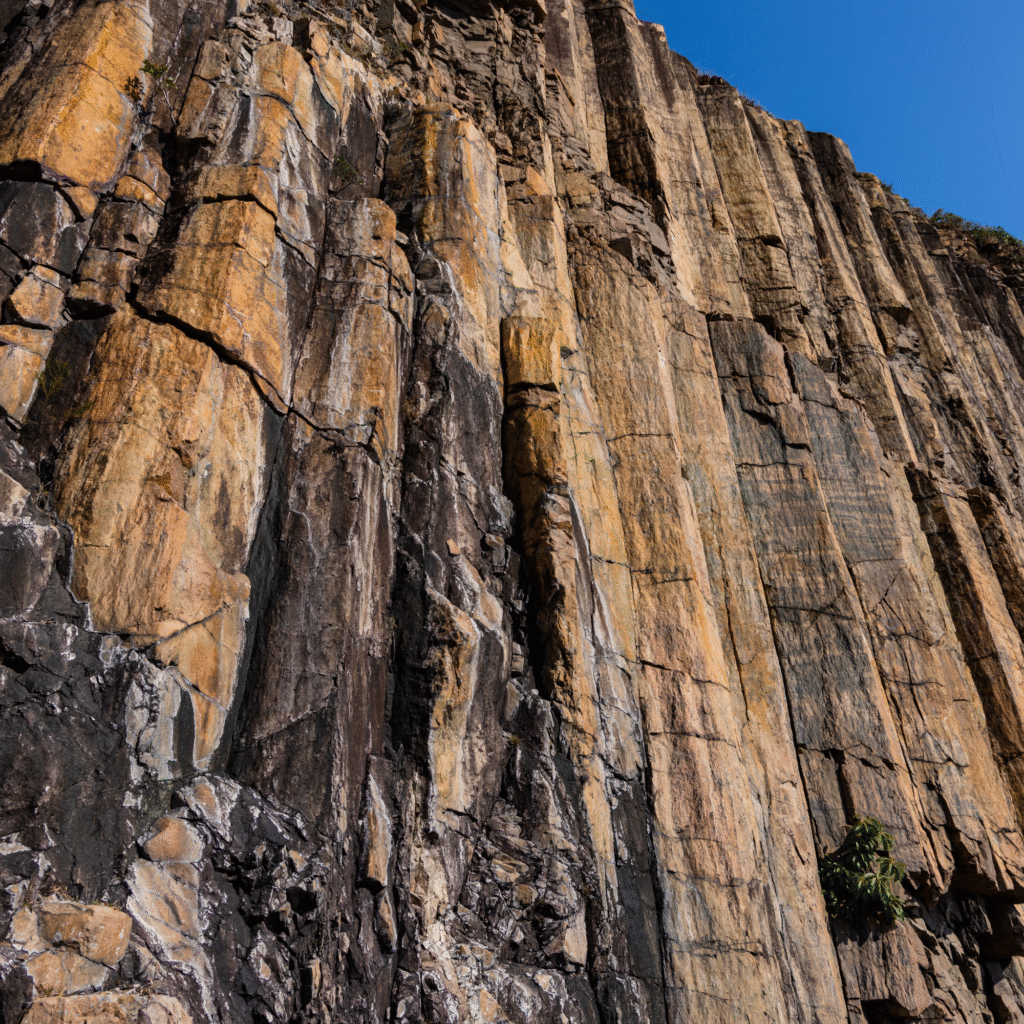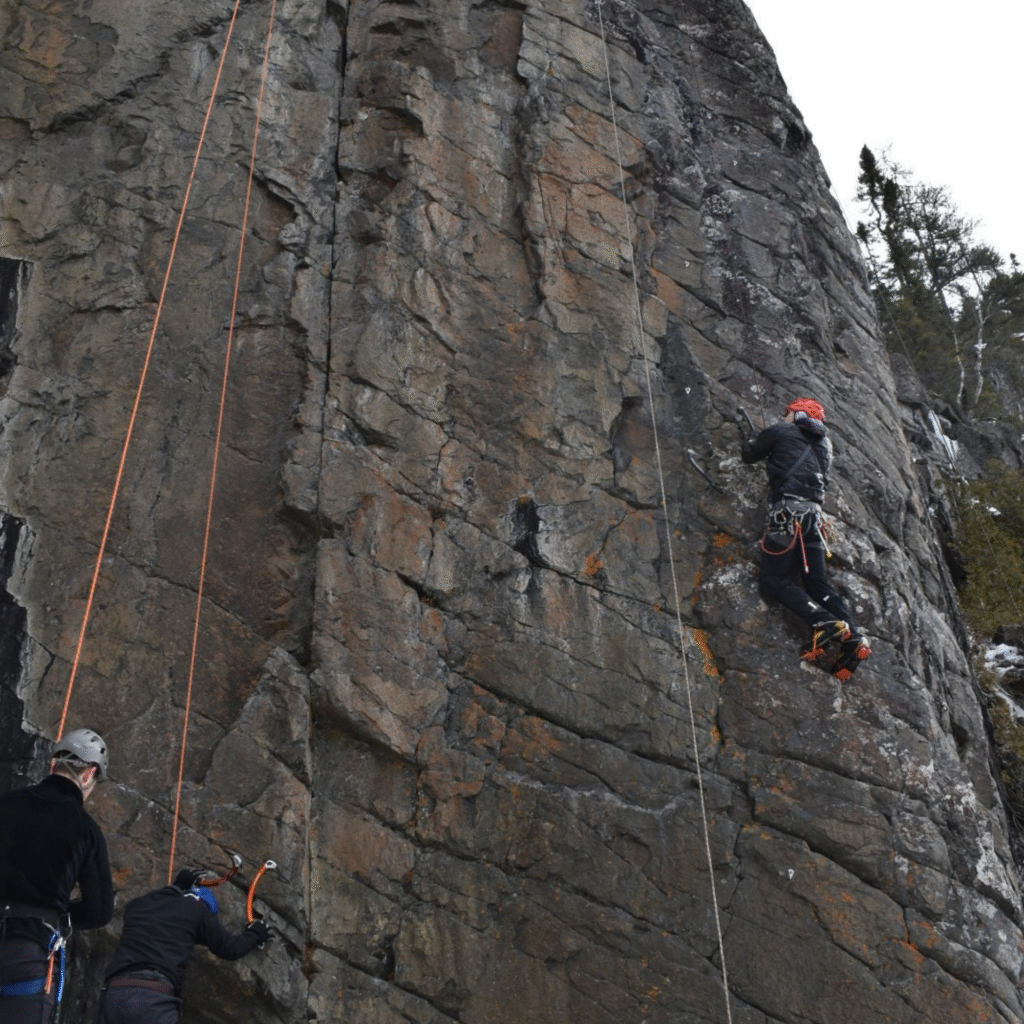Dry tooling blends the techniques of rock climbing and ice climbing, enabling climbers to ascend routes using ice axes and crampons on rock surfaces. Whether you’re preparing for the ice climbing season, enhancing your mixed climbing skills, or simply curious about this rapidly growing discipline, our dry tooling courses offer the perfect introduction.
Currently, we offer dry tooling courses exclusively upon request. If you or your group are interested in trying out dry tooling or progressing your skills, please reach out to arrange a custom course tailored specifically to your needs and experience level.
Don’t worry if you don’t have technical gear. Our guides generally provide the necessary equipment, including ice axes, crampons, helmets, harnesses, and ropes. You are responsible for bringing a good attitude… and appropriate clothing, sun protection, and food and water!
Contrary to what some might expect, dry tooling is quite approachable, particularly with guidance from expert climbing instructors. Although dry tooling is typically more challenging than ice climbing, the two disciplines complement each other effectively, and experience in one will enhance your proficiency in the other.
Dry tooling involves climbing rock routes using ice axes and crampons, traditionally ice-specific equipment. The sport employs traditional rock climbing protection such as quickdraws, and many routes are fully bolted.
Initially not considered a separate discipline, dry tooling evolved from alpine climbing, where climbers occasionally traversed rock sections between ice pillars. Over time, dry tooling emerged as its own sport, gaining significant popularity due to its unique challenges, fitness benefits, and year-round accessibility.
Dry tooling routes use a specialized grading system, ranging from D1 (beginner-friendly) to D16 (extremely challenging). Storm Giant in Fernie, Canada was the first route to be given a D16 grade. To understand the difficulty of such a route, watch the story of Gord McCarthur’s first ascent in 2017.
Mixed climbing combines dry tooling and ice climbing. Climbers ascend routes incorporating a mix of ice and rock terrain, using crampons and ice axes (and sometimes bare hands) to navigate the varying surfaces. Mixed climbing is essential for tackling many alpine routes.
Mixed climbing grades range from M1 to M16. The most challenging sections of advanced mixed routes often involve dry tooling on steep, overhanging terrain.
Climbers typically need the following specialized gear:
Tools and picks: Ice axes that are specifically rated for dry tooling.
Crampons: Monopoint crampons provide precision on rock routes.
Climbing Helmet: Essential for safety, protecting from potential falling debris or accidental contact with tools.
Climbing Harness
Ropes
Eye Protection: Safety goggles can protect your eyes if dirt or bits of rock fall as you climb.
Protection: Belay device, quickdraws, carabiners, cords, etc.
All essential technical gear is provided by your guides during dry tooling courses, ensuring a safe, hassle-free experience.
Currently, we offer rock climbing lessons in Ontario, British Columbia, and Alberta, and we’re constantly expanding our offerings. If you are interested in taking a course in another location, please contact us and we can organize a lesson for you.
When you are using crampons or ice axes, such as in dry tooling or mixed climbing, you need to practice safe rope management skills to minimize the risk of one of the sharp edges cutting the rope. Taking a course with a professional guide will ensure you learn the sport in a safe manner.
Schedule a meeting with us today and we can plan a custom dry tooling or mixed climbing course!
For every course, your guide will provide a clear list of equipment they’ll supply and items you’re responsible for bringing. Typically, technical gear such as rock shoes, crampons, and helmets are provided by your guide. You will need to bring non-technical items and personal provisions, including water, snacks, food, and suitable clothing.
For the beginner classes, none! For the more advanced classes, the prerequisites are listed in the course descriptions.
At Climb Onsight, we abide by the guide’s cancellation policy or an agreement between you and the guide. Often, you and the guide can reschedule the class to another day.
As a backdrop, the following cancellation policy in our terms and conditions applies:
(a) Fourteen (14) calendar days prior to the course: Customer is entitled to a full refund of the course.
(b) Seven (7) to thirteen (13) calendar days prior to the course: Customer is entitled to a credit equal to the cost of the course or a refund of fifty percent (50%) of the course cost.
(c) Six (6) calendar days or fewer prior to the course: Customer is not entitled to a refund.
The guide has the sole discretion to cancel the course because of the weather. If the guide cancels the course before it begins, you and the guide will work together to arrange an alternate date for the guided trip, a credit for the guide’s services, or an appropriate refund. We won’t offer refunds if the course is canceled once it begins, unless you and the guide agree otherwise.






We send out a monthly newsletter featuring special courses, new platform features, and the latest climbing news we’re excited to share.